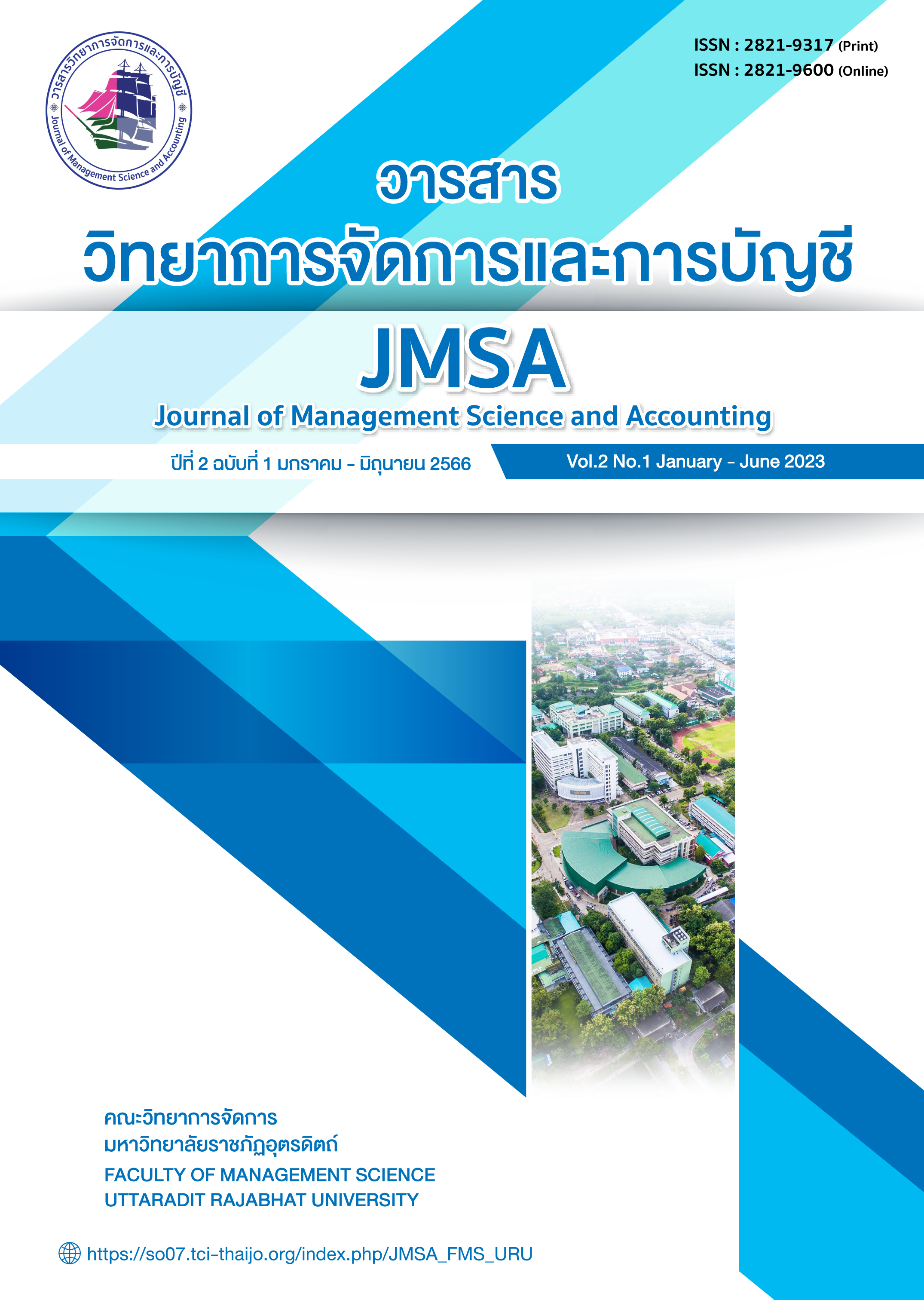Influence of Integrated Marketing Communication on Experiential Tourism Decisions of Thai Tourists
Main Article Content
Abstract
The purpose of this research was to study the influence of integrated marketing communication on experiential travel decision-making in Thailand. The research population is tourists who are interested and experienced in experiential tourism in Thailand. A questionnaire was used as a tool to collect data from the research sample selected through a convenience random sampling method, with 320 valid copies of the questionnaire returned. For the statistical analysis of this study, the researchers employed the PLS-SEM structural equation analysis. The results of the study were as follows: (1) Most of the respondents were female, aged between 20-30 years, single and a holder of a bachelor's degree; (2) The results of the descriptive statistical analysis of the study variables showed that respondents’ opinion for all variables was at a high level; (3) The path analysis of the structural equation model revealed that advertising and online marketing had a significant positive influence on experiential tourism decisions of Thai tourists, whereas direct marketing had a significant negative influence on experiential tourism decisions; (4) public relations, personal selling, and sales promotion had no influence on experiential tourism decisions of Thai tourists. It is suggested that marketing managers executing experiential tourism marketing strategies in Thailand should focus on integrated marketing communications in advertising, online marketing, and direct marketing.
Article Details

This work is licensed under a Creative Commons Attribution-NonCommercial-NoDerivatives 4.0 International License.
Articles published in the Journal of Management Science and Accounting Uttaradit Rajabhat University It is the copyright of Uttaradit Rajabhat University.
Articles published in Journal of Management Science and Accounting Uttaradit Rajabhat University Considered to be the personal opinion of the writer. The editorial board does not have to agree. Authors are responsible for their own articles.
Authors who publish agree to the following terms:
- Authors retain copyright and grant the journal right of first publication with the work simultaneously licensed under a Attribution-NonCommercial-NoDerivatives 4.0 International (CC BY-NC-ND 4.0) that allows others to share the work with an acknowledgment of the work's authorship and initial publication in this journal.
- Authors are able to enter into separate, additional contractual arrangements for the non-exclusive distribution of the journal's published version of the work (e.g., post it to an institutional repository or publish it in a book), with an acknowledgment of its initial publication in this journal.
- Authors are permitted and encouraged to post their work online (e.g., in institutional repositories or on their website) prior to and during the submission process, as it can lead to productive exchanges, as well as earlier and greater citation of published work.
References
กฤตยภัทร ธรรมรุจี. (2564). การสื่อสารการตลาดเพื่อการท่องเที่ยวชุมชนบ้านน้ำเชี่ยวจังหวัดตราด. (ปริญญามหาบัณฑิต). มหาวิทยาลัยราชภัฏรำไพพรรณี : จันทบุรี.
จุฑาธิปต์ จันทร์เอียด, อังสุมาลิน จำนงชอบ และ ณัฏฐพัชร มณีโรจน์. (2562). การวิจัยเชิงปฏิบัติการแบบมีส่วนร่วมในการจัดการการท่องเที่ยวเชิงประสบการณ์โดยชุมชนของกลุ่มชาติพันธุ์ลาวเวียง ตำบลศรีนาวา จังหวัดนครนายก. วารสารสหศาสตร์ศรีปทุม ชลบุรี, 5(1), 1-18.
ดวงศิริ ภูมิวิชชุเวช. (2559). การสื่อสารทางการตลาดสำหรับการท่องเที่ยวเพื่อเป็นรางวัลรูปแบบการท่องเที่ยวสีเขียวในจังหวัดเชียงราย. วารสารการท่องเที่ยวและการบริการ มหาวิทยาลัยราชภัฏเชียงราย, 3(1), 44-65.
ธัญวลัย หงส์ทอง. (2561). กลยุทธ์การตลาดเชิงประสบการณ์การท่องเที่ยวที่ส่งผลต่อการตัดสินใจเลือกสถานที่ท่องเที่ยวของนักท่องเที่ยวชาวต่างชาติในจังหวัดเชียงใหม่. (ปริญญามหาบัณฑิต). มหาวิทยาลัยกรุงเทพ : กรุงเทพฯ.
บุญตา วัฒนวานิชย์กุล. (2557). การพัฒนายุทธศาสตร์การสื่อสารการตลาดแบบบูรณาการเพื่อส่งเสริมการท่องเที่ยวเส้นทางสายไหมกลุ่มจังหวัดชัยบุรินทร์. https://doi.nrct.go.th/ListDoi/Download/439699/a3f87cbb8fcca1e07294dcfcef8baea1?Resolve_DOI=10.14457/STOU.the.2014.202
พิมุกต์ สมชอบ. (2560). โมเดลกลยุทธ์การสื่อสารการตลาดเพื่อดึงดูดการท่องเที่ยวจังหวัดอุบลราชธานี. วารสารวิจัยและประเมินผลอุบลราชธานี, 6(1), 29-38.
ภัสชา วงศ์ทิมารัตน์. (2558). ประสิทธิผลของการสื่อสารการตลาดแบบบูรณาการเพื่อสร้างภาพลักษณ์ธุรกิจสปา. วารสารมหาวิทยาลัยราชภัฏธนบุรี, 9(1), 106-124.
วรรณภา แตกปัญญา. (2559). แนวทางการพัฒนาการสื่อสารทางการตลาดของแหล่งท่องเที่ยวเชิงประวัติศาสตร์อำเภอพิมาย จังหวัดนครราชสีมา. (ปริญญามหาบัณฑิต). สถาบันบัณฑิตพัฒนบริหารศาสตร์ : กรุงเทพฯ.
อดิเทพ กำแพงเสรี, ศุภกรณ์ ดิษฐพันธุ์ และ สมศักดิ์ เชาว์ธาดาพงศ์. (2564). การสร้างกลยุทธ์การสื่อสารทางการตลาดเพื่อส่งเสริมกิจกรรมการท่องเที่ยวงานนิทรรศการศิลปะในจังหวัดนครราชสีมา. วารสารวิทยาลัยดุสิตธานี, 15(1), 417-430.
Chen, X., Cheng, Z. F., & Kim, G. B. (2020). Make it memorable: Tourism experience, fun, recommendation and revisit intention of Chinese outbound tourists. Sustainability, 12, 1-24.
Cochran, W. G. (1977). Sampling techniques. (3rd ed.). John Willey and Sons.
Cong, X. (2021). Research on the tourism decision-making mechanism: A case study of American outbound tourism. Informing Science: The International journal of an Emerging Transdiscipline, 24, 129-147.
Gelhard, C. & Delft, S. (2015). The role of strategic and value chain flexibility in achieving sustainability performance: An empirical analysis using conventional and consistent PLS. https://proceedings.utwente.nl/350/1/UsePLS_2015_submission_97.pdf
Hair, J. F., Black, W. C., Babin, B. J., & Anderson, R. E. (2014). Multivariate data analysis. (7th ed.). Pearson Education.
Hair, J. F., Hult, G. T. M., Ringle, C. M., & Sarstedt, M. (2017). A primer on partial least squares structural equation modeling. (2nd ed.). Sage.
Henche, B. G. (2018). Urban experiential tourism marketing: Use of social media as communication tools by the food markets of Madrid. Journal of Tourism Analysis, 25(1), 2-22.
Henseler, J. F., Ringle, C. M., & Sarstedt, M. (2015). A new criterion for assessing
discriminant validity in variance-based structural equation modeling. Journal of the Academy of Marketing Science, 43, 115-135.
Konwar, J. & Chakrabarty, N. (2020). Integrated marketing communication as an element of visitors’ selection of heritage destination: A theorical framework. International journal of Research in Engineering Application and Management, 5(10), 39-46.
Liu, X., Mehraliyev, F., Liu, C., & Schuckert, M. (2020). The roles of social media on tourists’ choices of travel components. Tourist Studies, 20(1), 27-48.
Nootayasakul, C. & Pasunon, P. (2016). Factors of decision making of Thai tourists’ traveling to Lampraya market, Nakhon pathom. Dusit Thani College Journal, 10(1), 132-150.
Saeed, R., Naeem, B., Bilal, M., & Naz, U. (2013). Integrated marketing communication: A review paper. Interdisciplinary Journal of Contemporary Research in Business, 5(5), 124-133.
Yiannakou, A., Apostolou, A., Birou-Athanasiou, V., Papagiannakis, A., & Vitopoulou, A. (2022). Branding places through experiential tourism: A survey on the features of the experiential product and enterprises in Geek regions. Tourism and Hospitality, 3, 435-450.

